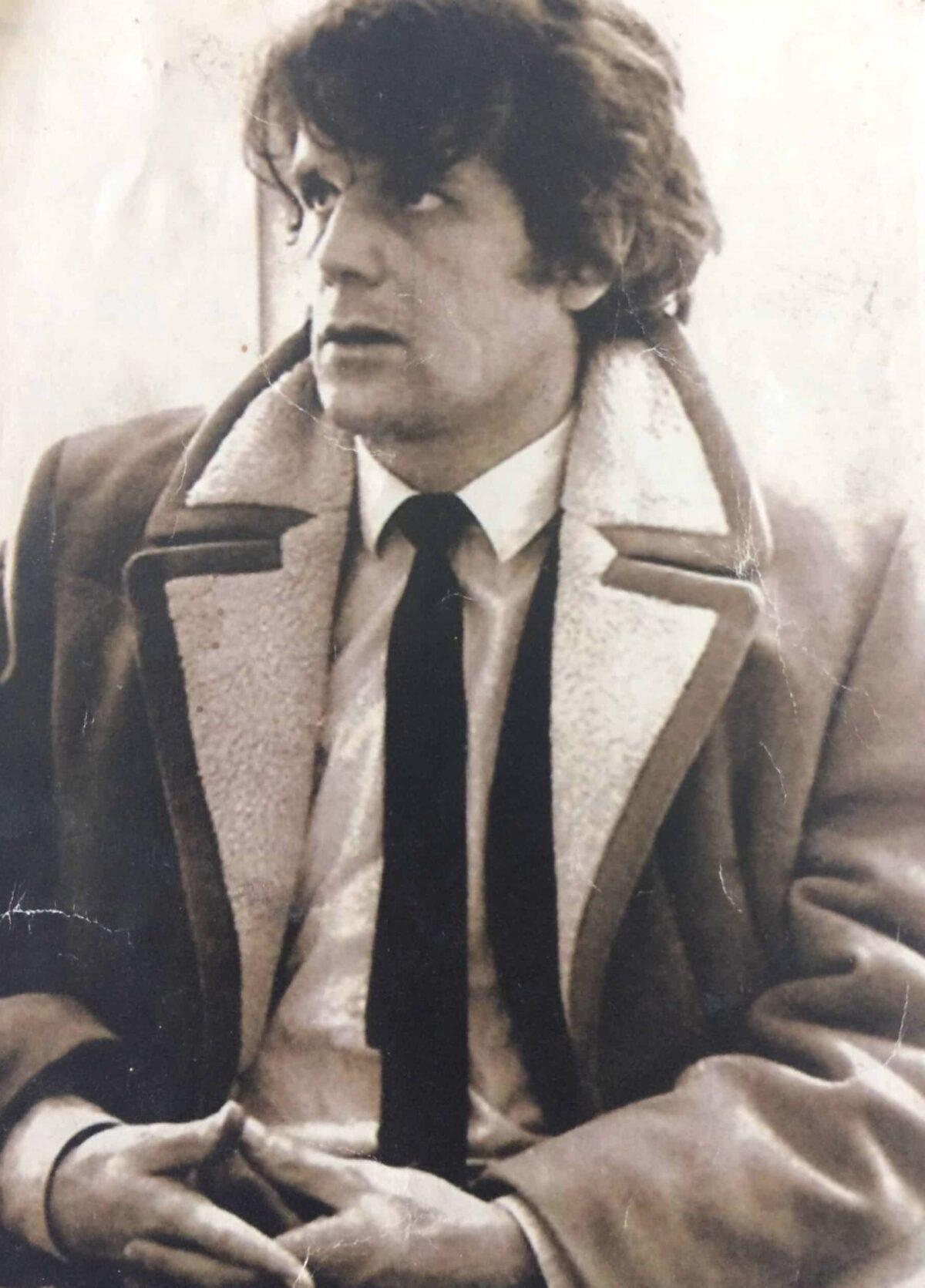This story / page is available in:
![]() German
German

John Moriarty. Irish philosopher, writer, mystic (1938 – 2007). John liked the photo taken by Don MacMonagle in 2006
“Unless there is wildness around you, something terrible happens to the wildness inside of you –
and if the wildness inside of you dies, then you are finished.”
John Moriarty
Part 1 of the Irlandnews series on John Moriarty
:: Für die deutsche Übersetzung hier klicken
Three days before St Patrick’s Day in 2019, I met a woman from the west of Ireland in a quiet place on the Beara Peninsula. I was researching the story of the Irish writer, poet and ex-priest John O’Donohue. The woman from Connemara read O’Donohue’s book Beauty and caught my attention. We were soon talking about John O’Donohue and it was from her that I first heard the name John Moriarty. She asked if I knew the other John. No, I didn’t know him. She had aroused my interest.
Five years have passed since then, the ten-part series on the life and work of John O’Donohue has appeared here in my web magazine Irlandnews.com*, and I have since got to know John Moriarty, the man from Mangerton, who had so much in common with O’Donohue and yet was fundamentally different from him. John Moriarty, the Irish philosopher, writer, poet and mystic from County Kerry, whom some called the shaman, always rejected public claims to him. He was not suited to be a guru, he was first committed to the earth and nature and then to civilisation. He was himself, he did what he said and what he thought was right. While O’Donohue remained romantic about nature, Moriarty was the philosopher of the wilderness and advocated for the wildness within us.
If you want to find out more about John Moriarty’s life (2 February 1938 – 1 June 2007), you should actually speak English. Reliable sources report in detail on the life of the thinker and myth diver who was deeply convinced that man now must sit down and pause to find his lost soul, that he should overcome the habit of linear thinking and relearn the cyclical, that he should try to rediscover and experience the Dreamtime and the message of the great myths – so that mankind has a future and can survive. For John Moriarty there exists an Irish as well as an Australian Dreamtime.
Born into a farming family in Moyvane, a village in North Kerry, John Stephen realised early on that humanity was on a steep downhill road to destruction. In 1971, at the age of 33, he abruptly ended his picture-book career and resigned from his position as a junior professor of philosophy in Manitoba, Canada. He returned to Ireland and from then on lived a modest contemplative life as a gardener in and with nature in Toombeola in Connemara.
Moriarty spent his days and many nights outdoors in the mountains, in woodlands, at ancient places of worship, by rivers and by the sea; he sat for hours among trees, meditated in nature and in wild places, he worked as a gardener, met, and lost the love of his life, overcame serious illnesses, and finally began writing. His first book, Dreamtime, was published in 1994. A year later, John moved to Coolies at the foot of Mangerton Mountain, south of Killarney. From 1995 until his death in 2007, he wrote and published ten more books there, including his autobiography Nostos, the trilogy Turtle Was Gone A Long Time and an account of his healing project Slí na Fírinne.
Little known even in Ireland during his lifetime, the philosopher, poet and contemporary diagnostician Moriarty is now recognised as one of Ireland’s most interesting and important, if not one of its greatest thinkers. His works have been compared to those of James Joyce due to their complexity – they are certainly not any easier to read.
Stand Beautifully on the Earth
By and by well read-people in Ireland realised how far ahead of his time Moriarty was, how clairvoyant his insights were, how accurate and profound his diagnosis of humanity’s alienation from nature and from themselves and of the destructiveness of the human species. “Stand Beautifully on the Earth”, Moriarty admonished us: Stand and walk in beauty on this earth – gently, mindfully, considerately, protectively, peacefully, wild and free. With a universal knowledge of human myths and cultures and with unique experiential wisdom, the time-travelling Moriarty created a body of thought for our salvation and for healing the wounds of the natural world.
Today, thinkers who were close to John or who have recognised the value of his work are endeavouring to make his rich and complex work better known, to interpret and to explain it to others. John writings and lectures provide answers that can be important for us today and for our survival – if we listen and learn to understand. The discussion of Moriarty’s books, which have so far only been published in English, has only hasppened in the English-speaking world. It its the aim of this series of articles to introduce the Irish philosopher-poet-mystic to people in the German-speaking world. Hope dies last, a friend joked, who wished me good luck in publicising a thinker in the German-speaking world who is still fairly unknown in this own English-Irish cultural domain.
John Moriarty liked to say: “The capacity for ordinariness is our final sanctity” – and this is what his everyday life looked like. In his simple house at the foot of the Kerry mountains, situated between Mangerton and Torc Mountain, with a view of the legendary Paps of Anu, John Moriarty lived simply and modestly. His niece Amanda Carmody describes it like this:
„John Moriarty lived a simple and ordinary life. His possessions were few, mostly his books, some house plants and a few sacred objects on the altar that he kept.
He always wore brown Ecco shoes, corduroy trousers and a pullover, usually a shade of red. For outdoors he had a wax jacket and scarf to keep the weather at bay.
He wrote longhand seated on a well worn fireside chair. Between the little altar and the open fire in the living room is where many of his books were conceived and written.He slept upstairs in a little dormer room and by his bed were a few books by the mystics ,a crooked cross of hazel and a rosary beads. He had very little furniture and no fitted kitchen or wardrobes. The walls and ceilings were plain white warmed by the pine joinery and floorboards.
John of course was a lifelong vegetarian and always tried to eat organic when he could. Porridge for breakfast and a simple evening meal , occasionally some brown bread and jam. I don’t think he drank tea of coffee or perhaps rarely.
Visiting was never boring, what you saw is what you got. There was always a magnificent welcome and If you asked John how he was, you needed to be prepared to listen to the answer because he would tell you. John in return was an attentive listener, a great storyteller and could be very witty.We often discussed dreams or he might ask my opinion on an idea or a bookcover design. John didn’t drive or own a car so I might sometimes drive Him to Killarney for groceries or to a medical appointment.
In fact John kept the entrance gate closed , cars didn’t come beyond the gate so that insects, snails, lichen etc would not be harmed.I once said in response to a comment he made “ are you not contradicting yourself there John?” His reply was “yes, I am full of contradictions” it was reassuring for me to hear this. John never wanted to be anything other than himself, he lived the best he could, and his mission was to write and give talks. Sometimes he might be at a packed venue, other times to half a dozen people. Regardless he delivered his talk with the same attention and passion.
Occasionally he might be annoyed about something, an old oak tree cut down in Killarney to create parking space near the cinema infuriated him for example. ”
Reliable information about John Moriarty and his complete works in English can be found here:
* The John Moriarty Institute for Ecology and Spirituality: The JMI is dedicated to publicising the life & work of the philosopher and supporting the ecological and spiritual concerns of John Moriarty. The Institute’s website is a rich source of texts, photos and videos by and about John. Website: Click.
* The JMI also runs a very active Facebook group with daily posts on John Moriarty. Because it’s for a good cause, here’s – as an exception to our policy – a link from Irlandnews to the John Moriarty Facebook-Group. Click.
* The Lilliput Press: John Moriarty’s books (so far all in English) are published by the Irish publishing house The Lilliput Press in Dublin. You get a good overview of John’s books and audio books on the publisher’s website. Website: Click.
John Moriarty died at home in Coolies on 1 June 2007 after a serious illness. Eileen Moore, the love of his life, had returned to him and accompanied him on the last stage of his life. John was buried high above Killarney’s Lough Leane in Aghadoe Cemetery. Inscribed on his headstone are these three phrases. They are his legacy in a nutshell:
Mitakuye oyasin: The term from the Lakota language means “We are all related”, or “We are all connected”, also: “We are all one”.
Stand beautifully on the earth: Beautiful here means at the same time graceful, dignified, mindful, considerate and respectful.
Ar shlí na fírinne: An old Irish term for death and the path to immortality, literally: on the path of truth. John Moriarty planned to found a monastic hedge school for adults. Designed in the shape of a flower, the retreat centre for up to 12 people was to become the nucleus for the renewal of a free Christian faith. John set out on the path of truth before the project in the mountains of South Kerry could begin.
16 years after John Moriarty’s death, I visited his place at Coolies just before Christmas and found the house, which is set back from the road. I wanted to see where and how the man had lived, what he had seen when he stepped out of the door into his natural garden with trees he had planted himself. Everything was still as he had left it and as Amanda had described it: the gate closed, the driveway to the house untouched, overgrown with grass. Trees, meadow, large, ancient stones – a soulful place, with a simple house on top of it, unpainted.
On the late afternoon of New Year’s Eve, I felt restless and the need to complete a long-awaited task before a new year would break: To find the place where John Moriarty wanted to found the hedge school Slí na Fírinne, the retreat place in the mountains between Kilgarvan and Gougane Barra. I had travelled to the townland of Cummeen Upper more than two years ago – only now, on the last day of 2023, was I to find the 23-acre piece of land in the lonely mountains of Kerry bordering West Cork. John Moriarty had bought a large piece of land here two decades ago. At dusk, I met Farmer Patsy, the man who showed me the way down through the Clover Field.
To be continued
Photos: Portraits of John Moriarty used with kind permission of The John Moriarty Institute.
Photos house and headstone: Markus Bäuchle
* The ten-part series about the Irish writer, philosopher and ex-priest John O’Donohue is available free of charge here: Klick
This story / page is available in:
![]() German
German






Leave A Comment